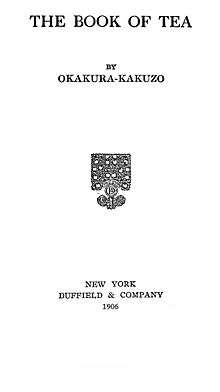The Book of Tea
The Book of Tea (茶の本, Cha no Hon) by Okakura Kakuzō[1] (1906) is a long essay linking the role of chadō (teaism) to the aesthetic and cultural aspects of Japanese life.
 Title page of the American edition of The Book of Tea | |
| Author | Okakura Kakuzō |
|---|---|
| Country | United States |
| Language | English |
| Publisher | Duffield & Company |
Publication date | 1906 |
| Pages | 160 |
Content
Addressed to a western audience, it was originally written in English and is one of the great English tea classics. Okakura had been taught at a young age to speak English and was proficient at communicating his thoughts to the Western mind. In his book, he discusses such topics as Zen and Taoism, but also the secular aspects of Tea and Japanese life. The book emphasizes how Teaism taught the Japanese many things; most importantly, simplicity. Kakuzō argues that this tea-induced simplicity affected art and architecture, and he was a long-time student of the visual arts. In the book, Kakuzō states that Teaism, in itself, is one of the profound universal remedies that two parties could sit down to. Kakuzō went on to mention that tea has been the subject of many historical events, such as peace treaties and the like. He ends the book with a chapter on Tea Masters and spends some time talking about Sen no Rikyū and his contribution to the Japanese tea ceremony.
According to Tomonobu Imamichi, Heidegger's concept of Dasein in Sein und Zeit was inspired – although Heidegger remained silent on this – by Okakura Kakuzō's concept of das-in-der-Welt-sein (being-in-the-worldness) expressed in The Book of Tea to describe Zhuangzi's philosophy, which Imamichi's professor Ito Kichinosuke had offered to Heidegger in 1919, after having followed private lessons with him the year before:[2]
‘Ito Kichinosuke, one of my teachers at university, studied in Germany in 1918 immediately after the First World War and hired Heidegger as a private tutor. Before moving back to Japan at the end of his studies, Professor Ito handed Heidegger a copy of Das Buch vom Tee, the German translation of Okakura Kakuzo’s The Book of Tea, as a token of his appreciation. That was in 1919. Sein und Zeit (Being and Time) was published in 1927 and made Heidegger famous. Mr. Ito was surprised and indignant that Heidegger used Zhuangzi’s concept without giving him credit. Years later in 1945, Professor Ito reminisced with me and, speaking in his Shonai dialect, said, ‘Heidegger did a lot for me, but I should’ve laid into him for stealing’. There are other indications that Heidegger was inspired by Eastern writings, but let’s leave this topic here. I have heard many stories of this kind from Professor Ito and checked their veracity. I recounted this story at a reception held after a series of lectures I gave in 1968 at the University of Heidelberg at the invitation of Hans-Georg Gadamer. Japanese exchange students attended these lectures, and I explained that there were many other elements of classical Eastern thought in Heidegger’s philosophy and gave some examples. I must have said too much and may even have said that Heidegger was a plagiarist (Plagiator). Gadamer was Heidegger’s favorite student, and we ended up not speaking to each other for 4 or 5 years because he was so angry with me’ (Imamichi 2004, pp. 123–124).[3][4]
Quotes
It (Teaism) inculcates purity and harmony, the mystery of mutual charity, the romanticism of the social order. It is essentially a worship of the Imperfect, as it is a tender attempt to accomplish something possible in this impossible thing we know as life.
See also
References
Citations
- 'Ambassador of Tea Culture to the West' (biography of Okakura), Andrew Forbes and David Henley, The Illustrated Book of Tea (Chiang Mai: Cognoscenti Books, 2012).
- Tomonubu Imamichi, In Search of Wisdom. One Philosopher’s Journey, Tokyo, International House of Japan, 2004 (quoted by Anne Fagot-Largeau at her lesson at the College of France of December 7, 2006) Archived February 6, 2009, at the Wayback Machine
- Imamichi, Tomonobu (2004). In search of wisdom: one philosopher's journey. Tokyo: International House of Japan. pp. 123–124.
- Marion, Mathieu (2014). "Wittgenstein on Heidegger and Cosmic Emotions". Mind, Values, and Metaphysics. 1 (Philosophical Essays in Honor of Kevin Mulligan): 441. ISBN 978-3-319-04199-5 – via https://www.springer.com/la/book/9783319041988.
Sources
- The Illustrated Book of Tea (Okakura's classic illustrated with 17th-19th century ukiyo-e woodblock prints of Japanese tea culture). Chiang Mai: Cognoscenti Books. 2012. ASIN B009033C6M.